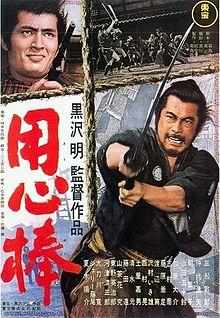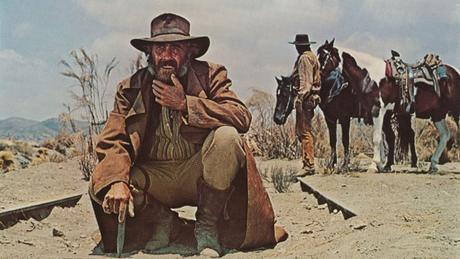
"Stagecoach" and The Traditional Western
With arguably the genre's most quintessential director, John Ford, lead actor, John Wayne, and scenic location, Monument Valley, this black-and-white classic employs every trope of the genre in a tight 1 hour and 40 minute package. Storywise, it's the subplots and the humor that make this movie great. Many playful vignettes, featuring expert character actors of their day, paint life on the frontier as cheap, justice as obsolete, and morality as ambiguous. This lighthearted humor juxtaposed against sobering reality would be used to full effect 30 years later in the "Spaghetti Western" subgenre.The plot's main protagonists and love interests, an outlaw and a prostitute, are morally corrupt by civilized societies standards, yet pure of heart. The story hinges on a classic revenge story, in which John Wayne's character, the outlaw, carries out vigilante justice against his brother and father's killer. This is complicated by the friendship between him and The Marshall, representing formal law and order, who empathizes with the outlaw's motivation, but is bound by duty. This conflict between civilized and frontier justice is a hallmark of the genre.The film also features a perilous journey, a cowboy vs. Indians shootout (more on that later), a deus ex machina by the U.S. cavalry, a fixation on whiskey, and the pursuit of the American Dream in a hostile lawless land, all traditions of the Western model. And, spoiler alert, the story concludes with the obligatory ride into the sunset.
"Seven Samurai", "Yojimbo", and the Eastern Influence on the WesternIt may come as a surprise to lovers of the great American Western that no artist had stronger influence on the next evolution of the genre than Japanese director and visionary genius, Akira Kurosawa. Kurosawa's films "Seven Samurai" and "Yojimbo" transposed Western archetypes onto a traditional Japanese backdrop. Both were swiftly adapted into classics "The Magnificent Seven" and "A Fistfull of Dollars" in the 50s and 60s. Samurai for hire in feudal Japan, or Ronin, were the perfect avatar for the mercenary gunmen of the classic Western. In "Seven Samurai", a group of Ronin are hired by a poor village for protection from an impending raid by bandits. The ragtag group of caricatures are reminiscent of the passengers in "Stagecoach". In "Yojimbo", a Ronin exploits the greed and corruption of a village overrun by gangs and warlords, playing them against each other to their mutual demise. Clint Eastwood would later recreate actor Toshiro Mifune's archetypal character playing a drifter, a man with no allegiances who can rely only on himself and yields to no code but his own, stoic, deft, and deadly. Both characters are presented as having no name.

The Spaghetti Western: "Once Upon a Time in The West" and "The Good, The Bad, and The Ugly"The next major movement of the Western also took place outside The States, in the mid-60s. Often directed by Sergio Leone, scored by Ennio Morricone, and starring Clint Eastwood, these Italian-international films were made on a low budget, starred local actors, filmed in a desert in Spain, and synched in English in post production. In "Once Upon a Time in the West", a revenge story runs parallel to a bloody race for a valuable piece of land. In "The Good, The Bad, and the Ugly", three money-hungry gunmen wheel and deal one another in pursuit of a dead man's treasure. The name "Spaghetti Western" mirrors the cookey irreverent ironic humor these films often employ, not unlike "Stagecoach", in their treatment of death, greed, poverty, and war. Leone's Westerns, much to the distaste of the old school, exploit the mythos of the genre to reveal the hypocrisy beneath. In Leone's West, life is cheap, death is waiting around every corner, and loyalty is precarious, even for his heroes. This depiction of the Wild West reflected the American counterculture's view of Vietnam, a lawless land, where good and evil are blurred, and hypocrisy reigns. This period coincided with films like "Bonnie and Clyde", "Easy Rider", and "Butch Cassidy and the Sundance Kid", quasi-Westerns with similarly anti-establishment themes. Characters in Spaghetti Westerns appealed to Americans yearning to start over, reinvent what it is the to be an American, seeing the new frontier as a blank slate. It's worth noting here that cultural awareness surrounding the genocide of Native American tribes would soon become problematic for the genre.

Things Get Weird with "El Topo" and "Dead Man"
(Caution: Spoilers below.)Inspired by the Spaghetti Western, the counterculture took the next logical step, fusing it with 60s psychedelia to create a subgenre known as the "Acid Western", a movement that would begin, yet again, outside The States. Chilean director Alejandro Jodorowsky's seminal midnight movie "El Topo", produced in Mexico, founded the genre. The story follows a black duster and wide-brimmed-hat wearing semi-nameless hero, who goes on a transcendental quest culminating in a god-like transformation set against a desert sandscape. The cryptic story, taboo even by today's standards, is told through a mixture of spiritual symbolism and classic Western tropes. In the latter half of the film, our newly transformed hero attempts to save a colony of deformed people victimized by a morally corrupt town, ultimately leading to his death. This new kind of Western hero can no longer remain passive and self-serving in the face of injustice. 25 years later, the second most influential film of the genre, Jim Jarmusch's "Dead Man" from 1995, was released. Like "Dances with Wolves" 5 years earlier, "Dead Man" begins to offer reparations for the highly offensive misrepresentation of Natives central to the genre since its beginnings. As in "El Topo", the protagonist undergoes a spiritual transformation, ultimately leading to his own death, as well as the deaths of his spiritual mentor and his blood-thirsty mercenary pursuer. As in "El Topo", his transformation draws him out of passivity. Although the protagonist seems to find inner strength through connection with a higher power, the plot eventually concludes nihilistically.

"Unforgiven" and the Defiance of the Genre
In post-Vietnam America, stories of American triumph over indigenous cultures or clear-cut tales of good conquering evil were harder for moviegoers to stomach. The next iteration of the genre, known as "The Revisionist Western" would grapple with guilt, consequences, self-reflection, escapism, self-abuse, and PTSD, abandoning the romanticism of the Old West in favor of sobering realism. In "Unforgiven" from 1992, directed and starring Clint Eastwood, an older and wiser version of who is essentially The Man with No Name attempts to redeem himself for the sins of his past, but finds he can't escape it, in some ways representing American nationalism itself. Our new hero can say things like "I'm scared of dying" and not appear as weak, but rather, as wise and morally mature.
 Guest Post: Tori Galatro is a freelance writer based in Austin, TX who would love to write about film for you.
Guest Post: Tori Galatro is a freelance writer based in Austin, TX who would love to write about film for you.